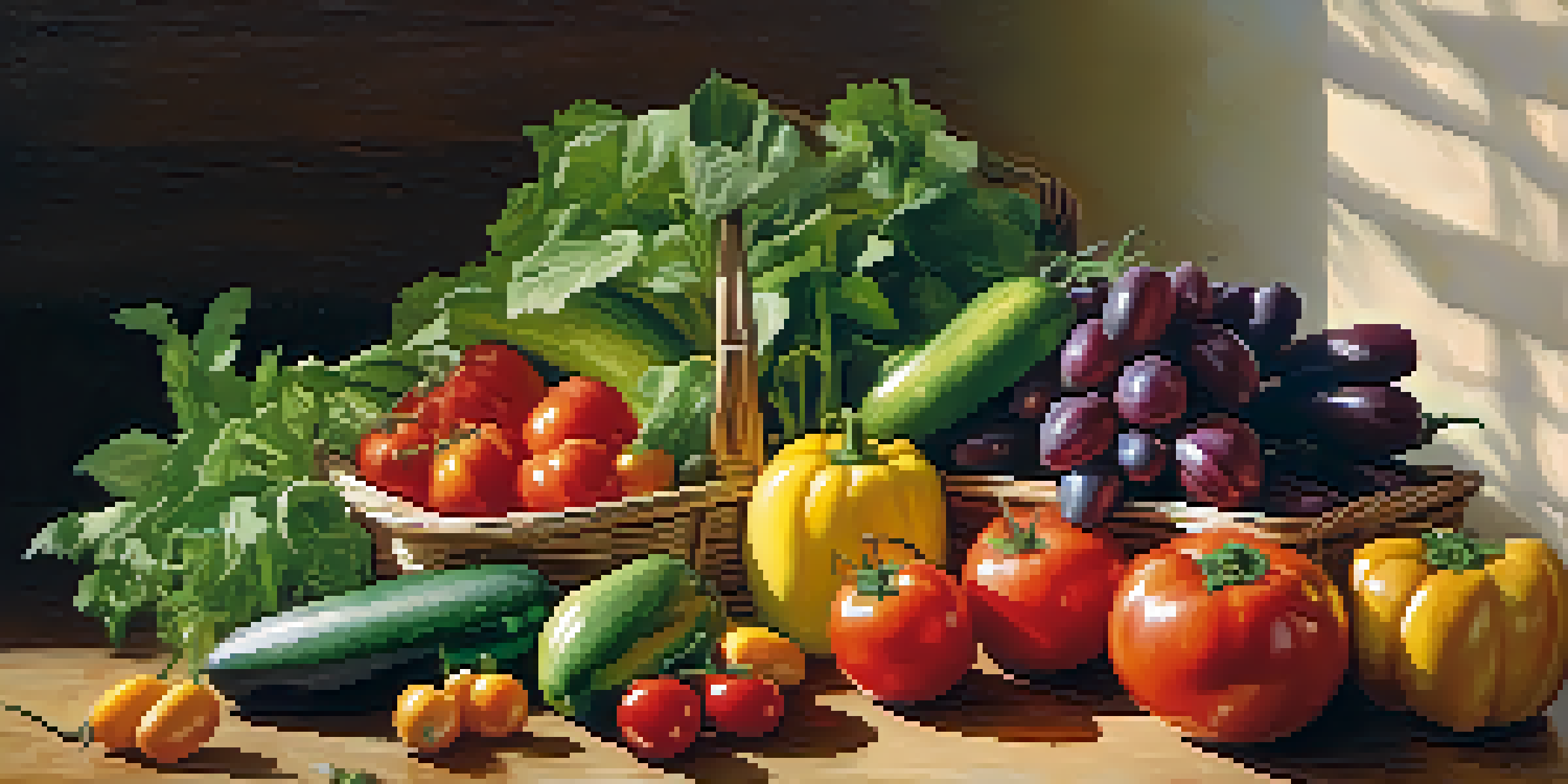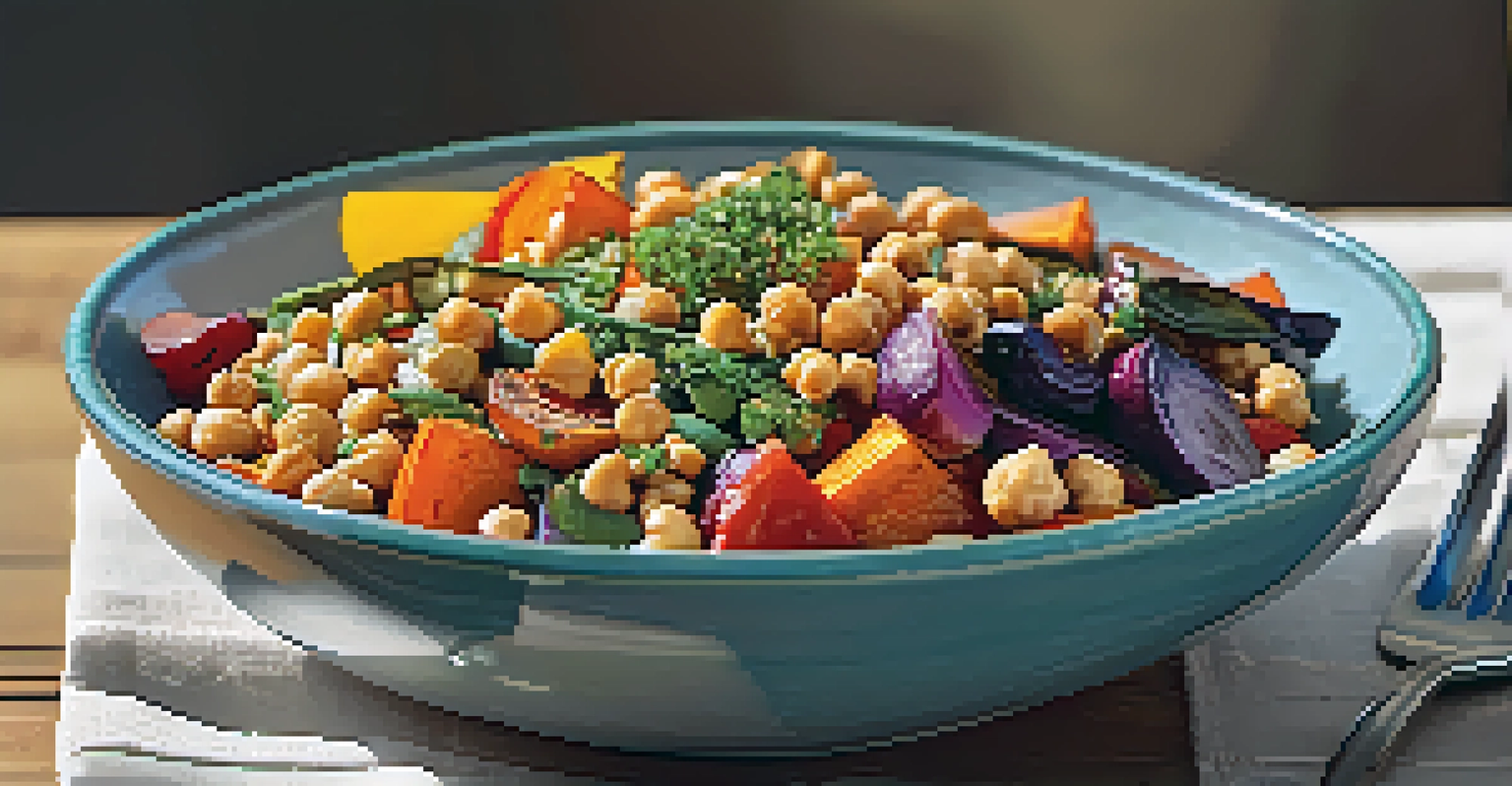How to Create Balanced Plant-Based Meals on a Budget

Understanding Plant-Based Nutrition Basics
Plant-based nutrition focuses on foods derived from plants, including fruits, vegetables, legumes, nuts, and whole grains. This type of diet can provide all the essential nutrients your body needs, such as protein, vitamins, and minerals, when balanced correctly. Understanding the basics of macronutrients—carbohydrates, proteins, and fats—will help you create meals that are not only healthy but also satisfying.
Let food be thy medicine and medicine be thy food.
For example, pairing legumes like lentils or chickpeas with whole grains such as brown rice or quinoa can create a complete protein. This is especially important in plant-based diets, as many plant proteins lack certain amino acids. By combining different food sources, you can ensure your meals are both nourishing and delicious.
Additionally, don't forget about the importance of vitamins and minerals. Foods like leafy greens, nuts, and seeds are packed with essential nutrients that support overall health. A well-rounded plant-based meal will include a variety of these foods to meet your nutritional needs while staying within budget.
Shopping Smart: Budget-Friendly Plant-Based Ingredients
One of the keys to creating balanced plant-based meals on a budget is shopping smart. Start by making a grocery list that focuses on affordable staples, such as beans, lentils, rice, oats, and seasonal vegetables. These items not only provide a great nutritional profile but are typically cheaper than processed foods or specialty products.

Buying in bulk can also save you money. Ingredients like grains and legumes are often less expensive when purchased in larger quantities. This approach not only helps you save money but also reduces packaging waste, making it a win-win for your wallet and the environment.
Plant-Based Nutrition Basics
A balanced plant-based diet includes a variety of foods like fruits, vegetables, and legumes to provide essential nutrients.
Don't overlook local farmers' markets or community-supported agriculture (CSA) programs. These options often provide fresh, seasonal produce at lower prices than traditional grocery stores. Plus, you get the added benefit of supporting local farmers and enjoying the freshest ingredients available.
Meal Planning: The Secret to Saving Time and Money
Meal planning is a game changer when it comes to creating balanced plant-based meals on a budget. By dedicating a little time each week to plan your meals, you can avoid impulse buys and ensure you're making the most of your ingredients. Start by choosing a few recipes that use similar ingredients, allowing you to minimize waste and cut costs.
Eating seasonally is not only good for your health but also for the planet.
For instance, if you buy a bunch of kale, plan to use it in multiple meals throughout the week. You can toss it in salads, sauté it as a side dish, or blend it into smoothies. This not only helps you save money but also keeps your meals interesting and varied.
You can also prepare larger batches of meals and freeze portions for later. This way, you have healthy options ready to go, making it easier to stick to your budget without sacrificing nutrition. Plus, having homemade meals on hand can save you from the temptation of ordering takeout.
Incorporating Affordable Proteins into Your Meals
Protein is an essential component of any balanced meal, and there are plenty of affordable plant-based protein sources to choose from. Beans, lentils, tofu, and tempeh are not only rich in protein but also budget-friendly. Incorporating these ingredients into your meals can help you meet your protein needs without breaking the bank.
For example, a hearty bean chili or a lentil soup can provide ample protein and be made in large batches for leftovers. You can also experiment with tofu in stir-fries or tempeh in sandwiches for a delicious protein boost. Mixing and matching these proteins throughout the week keeps your meals exciting.
Smart Shopping for Budget Meals
Shopping for affordable staples and buying in bulk can help you create nutritious plant-based meals without overspending.
Don’t forget about nuts and seeds, which can add protein and healthy fats to your meals. While they can be a bit pricier, buying them in bulk can help reduce costs. Add a sprinkle of chia seeds to your morning oatmeal or toss some nuts into your salads for extra crunch and nutrition.
Bulk Cooking: Save Time and Money with Big Batches
Bulk cooking is an excellent strategy for anyone looking to create balanced meals on a budget. By preparing larger quantities of food at once, you can save time during the week and reduce the temptation to eat out. Consider dedicating a day each week to cook and prepare meals that can be easily reheated.
For instance, cooking a large pot of vegetable soup or a casserole can yield several servings, providing you with meals for multiple days. Portion these meals into containers for easy grab-and-go options. This method not only saves time but also ensures you always have a healthy meal on hand.
Additionally, bulk cooking can help you make the most of seasonal ingredients. When produce is in season and at its cheapest, preparing large batches allows you to enjoy those flavors long after the harvest. You can freeze portions for later use, ensuring that you have delicious, home-cooked meals available anytime.
Creative Ways to Use Leftovers in New Meals
Leftovers can be a fantastic way to save money and reduce waste while creating balanced meals. Rather than letting extra food sit in the fridge, think creatively about how to repurpose it into new dishes. For example, leftover roasted vegetables can be turned into a hearty grain bowl or added to a frittata for breakfast.
If you have remaining grains like quinoa or brown rice, they can easily be incorporated into salads or stir-fries. This not only helps you make the most of your ingredients but also keeps your meals fresh and interesting throughout the week. The key is to get imaginative and see what combinations work best for you.
Creative Uses for Leftovers
Transforming leftovers into new meals not only reduces waste but also keeps your weekly menu exciting and varied.
You can also blend leftover soups or sauces into smoothies or marinades, giving them a new life while adding flavor to other dishes. Embracing leftovers not only saves money but also encourages creativity in the kitchen, making meal prep a fun and rewarding experience.
Seasonal Eating: Enjoy Fresh Produce on a Budget
Eating seasonally is a great way to incorporate fresh produce into your plant-based meals while saving money. Seasonal fruits and vegetables are often more affordable and taste better than out-of-season options. By focusing on what's in season, you can create meals that are not only nutritious but also bursting with flavor.
For example, in the summer, you might enjoy fresh tomatoes, zucchini, and bell peppers in a vibrant ratatouille, while winter brings hearty root vegetables like carrots and sweet potatoes that work wonderfully in soups and stews. Shopping for seasonal produce encourages variety in your meals and helps you connect with the changing seasons.

You can also take advantage of sales and discounts on seasonal items at your local grocery store or farmers' market. Planning your meals around these deals will not only enhance your diet but also keep your grocery budget in check. Embracing seasonal eating is a delicious way to enjoy the natural bounty of each season.